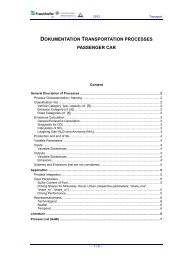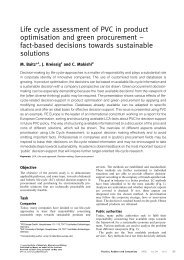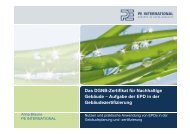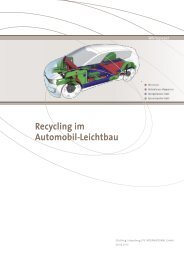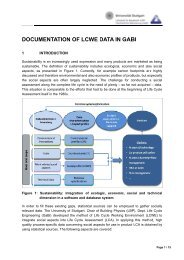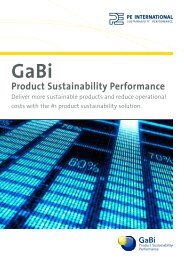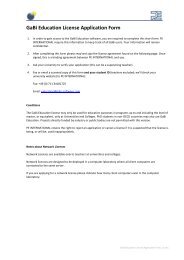Paper_Clip_Tutorial Part1.pdf - GaBi Software
Paper_Clip_Tutorial Part1.pdf - GaBi Software
Paper_Clip_Tutorial Part1.pdf - GaBi Software
You also want an ePaper? Increase the reach of your titles
YUMPU automatically turns print PDFs into web optimized ePapers that Google loves.
Conducting Life Cycle Assessments<br />
Figure 5: Allocation Example<br />
Figure 5 shows an example of a process where two products are produced. The<br />
resources used in this process and the emissions and wastes of the process have to be<br />
allocated to the two products. When the allocation is done proportionally to the product’s<br />
masses, product A would be assigned 90% of the resources and emissions, since the<br />
mass of product A is 90% of the overall mass of all products. If the allocation was done<br />
according to the products heating value, product A would be ascribed 99% of the<br />
resources and emissions.<br />
Since the choice of the allocation method can have a significant impact on the LCA results<br />
the ISO suggests that allocation should be avoided whenever possible. If it cannot be<br />
avoided, the allocation method should be described and the sensitivity of the results on<br />
different allocation methods should be described. The ISO also suggests that allocation<br />
according to physical relationships such as product mass or heating value rather than<br />
using non-physical relationships between the products (for example the market price).<br />
There are two ways to avoid allocation, substitution and system expansion. The topic of<br />
allocation requires much more explanation and is not covered in more detail here.<br />
2.1.2.5 Data Quality Requirements<br />
Data quality requirements must be documented to define the required properties of the<br />
data for the study. Descriptions of data quality are important because the data quality has<br />
a significant influence on the results of the LCA study. Data quality requirements have to<br />
be determined at the beginning of the study. Mostly, data quality is a trade off between<br />
feasibility and completeness.<br />
The quality of a dataset can only be assessed if the characteristics of the data are<br />
sufficiently documented. Data quality does, therefore, correspond to the documentation<br />
quality.<br />
The following issues should be considered for the data quality:<br />
• Data acquisition: Is the data measured, calculated or estimated? How much of<br />
the data required is primary data (in %) and how much data is taken from literature<br />
and databases (secondary data)?<br />
16



